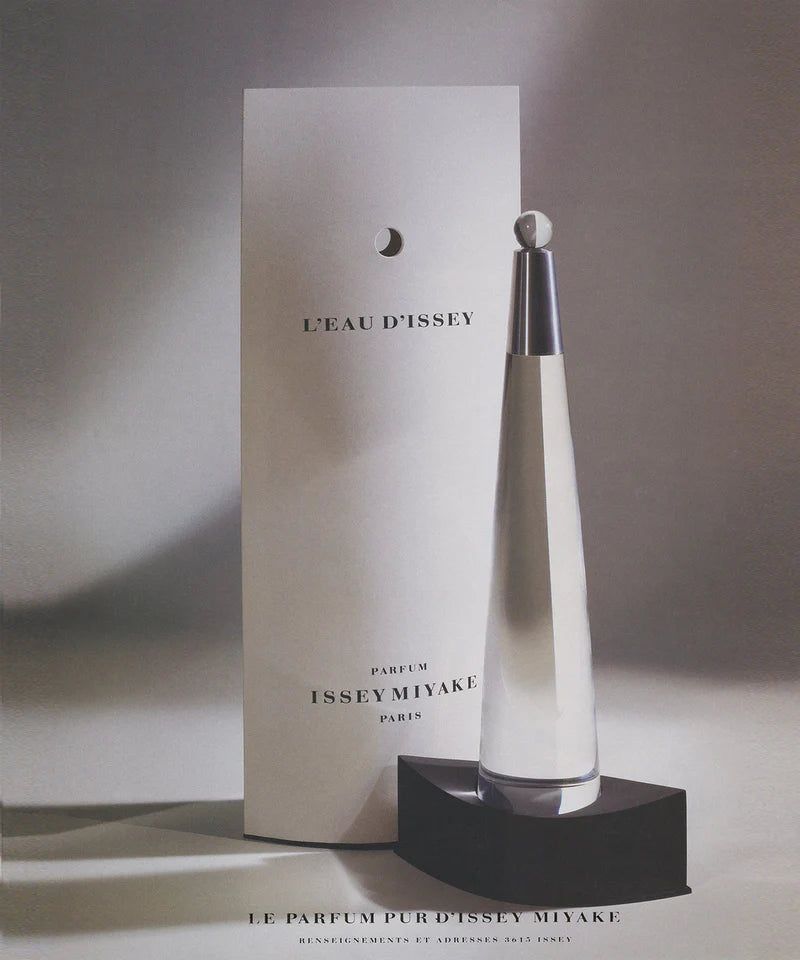Episode 9
“Shaping the Future with Light”
by Patrick Reymond (atelier oï)
A piece of cloth, a single wire, one light source. Despite its primitive structure, the light is free and gentle. The “TYPE-XIII Atelier Oï project”, set to unveil at Milan Design Week 2025, is the result of a fruitful collaboration between A-POC ABLE ISSEY MIYAKE and the Swiss architectural and design studio, atelier oï. Both are deeply committed to exploring materials and value craftsmanship and teamwork. These shared perspectives became evident through conversations with Patrick Reymond, one of atelier oï’s founders.
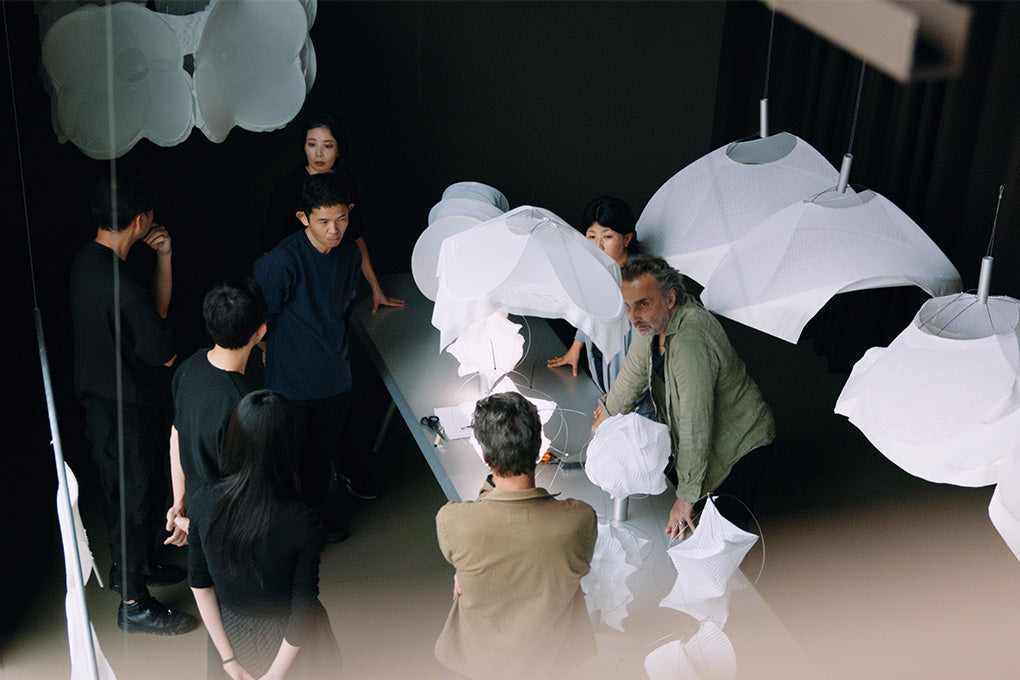
It resembles a white flower, softly glowing. The shade, formed by fabric and a wire frame, accentuates the inherent beauty of materials and structure (two words that repeatedly emerged in this dialogue). It also embodies functionality and freedom, bringing a new sense of joy to daily life. The lighting unveiled as the “TYPE-XIII Atelier Oï project” consists of two series: “O Series” and “A Series”.
The “O Series” is a freestanding light. Its shade combines delicate, three-dimensional pleated textiles created by A-POC ABLE’s unique “Steam Stretch” manufacturing process, together with an elliptical wire structure designed by atelier oï. The light source was developed in collaboration with Ambientec, an innovative portable lighting manufacturer from Japan. The light is easy to carry, and the shade has a flexible adaptability, reminiscent of flowers and plants that change their expression with time and seasons.
The “A Series” is a pendant light, made from a seamless, three-dimensional knit fabric (the starting point of A-POC, still known today as TYPE-A). The shade’s shape is pre-knitted into the fabric, with a wire frame inserted to create a sculptural form. The shade can be cut to adjust its shape and size to fit different spaces. This project is supported by the Spanish lighting brand PARACHILNA.
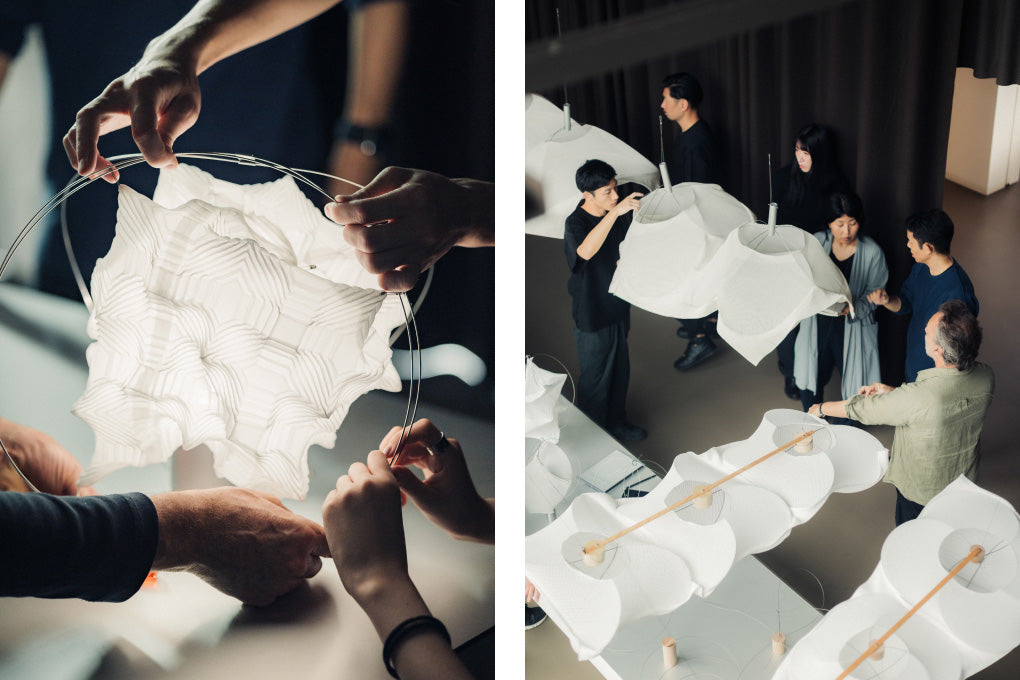
In brief, both series aim to maximize the potential of a single piece of cloth, not in the realm of clothing, but in lighting, which is a completely new domain. How could this experiment come to life in such a beautiful, functional and delightful form? Through a dialogue with Patrick Reymond, one of atelier oï’s founders, we explore this question.
──The “TYPE-XIII Atelier Oï project” will be unveiled at Issey Miyake’s Milan flagship store during Milan Design Week 2025. Interestingly, the inspiration for this project stemmed from the “TYPE-V Nature Architects project” exhibited at Milan Design Week 2023.
Yoshiyuki Miyamae (“Miyamae” below): That’s right. Patrick and the rest of the atelier oï team came to see our exhibition in Milan. That encounter was the starting point for this collaboration.
Patrick Reymond (“Patrick” below): It has already been more or less two years since then. Meeting Miyamae and his team at Milan Design Week 2023 was an incredible opportunity for us. What fascinated me most about A-POC ABLE’s exhibition was how a single new textile could serve as the starting point for an exploration that extended across various scales: from clothing to lighting, and even something like architecture.
I actually have a funny story about that visit. When I visited the exhibition, Miyamae guided me starting from the first floor. As I looked at the jackets and spherical prototypes on display, I said, “This could be applied to lighting or even furniture, don’t you think?” Then Miyamae responded, “Wait a moment”. He continued to lead me to the next floor, where they were showcasing lighting prototypes made from the same textiles. I was impressed and said, “If you scale this up further, it could even become architectural”. Again, Miyamae smiled and said, “Wait, wait!” He then guided me to another room, where they were actually exhibiting architectural models based on the same concept! (laughs)
Miyamae: (Laughs) That’s right. Patrick immediately resonated with the vision that A-POC ABLE is striving toward.
Patrick: What made that exhibition so remarkable was that it wasn’t just about showcasing works. It became a space for exploring new possibilities together. And before we even realized it, we had already become part of the process of developing those possibilities. We started asking ourselves: How can we give shape to the potential of this material? How should we explore the structure of this textile? Could it be applied to different fields? These questions had already begun in our minds.
The potential of textiles as a material and the efficiency of structural applications- I felt that A-POC ABLE’s project was actually challenging many of the issues that we, as well as society and product design as a whole, have been grappling with.
──The pursuit of material’s potential seems to be one of the most important aspects of atelier oï’s philosophy. What does material mean in the context of your design approach?
Patrick: When Aurel (Aebi), Armand (Louis), and I founded atelier oï in 1991, we had already been conducting workshops on materials and tools for some time. For example, Armand has a background as a shipbuilder, and in those workshops we researched methods that directly connected shipbuilding techniques and materials to design. This is because shipbuilding is inseparable from material innovation.
Especially in a field like competitive boat racing, where innovation is required down to the second, the exploration of new materials is essential. One of the key lessons we learned was the importance of thoroughly understanding materials. This isn’t just about their characteristics, it includes the technology and logic behind them, as well as the way they appeal to the senses through texture and feel. When design is used appropriately, it naturally emerges in alignment with the essence of the material itself. That’s why we must first understand the material. It is what guides and leads us in our creative process.
Miyamae: As someone who has continuously explored new possibilities for textiles, I deeply resonate with that perspective. A proper understanding of materials is a crucial part of the design process. It establishes the foundation for everything that follows.
Patrick: That’s probably why we feel such a strong connection. Another crucial aspect of our material research is always taking specific contexts and situations into consideration. For example, building a house in the mountains and building one by the sea are entirely different matters, including the environment. Working with A-POC ABLE’s textiles brings out a completely different context from, let’s say, designing with glass. Each material presents its own unique conditions and requirements.
Through this kind of material exploration, we gradually build an archive, like chefs developing their recipes over time. We call this a “Living Archive”, and with it, we explore what new possibilities might emerge. These newly discovered possibilities become the unique context of each project and grow into a fitting story. From a single project, we develop a specific narrative, which then serves as the foundation for further imagination and design.
This might explain why it’s difficult to pinpoint a distinctive “atelier oï style” in our projects. We don’t follow a single predefined aesthetic. Instead, our designs change based on the materials, context and situation. But we do believe that all our work shares a certain tactile quality. We call this “Storytecture”, and it is the true signature of atelier oï.
By understanding the project’s context, analyzing the logic of materials, drawing elements from our archive and engaging in repeated experimentation, we gradually bring the story to life. This repeating process is what shapes our “Storytecture”. Of course in the final stage, we put pen to paper and physically sketch our designs. But we see that as the intrinsic outcome of everything we’ve learned, the materials, structures, contexts, and narratives we have explored along the way. In the end, our design process is about allowing the story and material to naturally emerge, shaping them into form.
──Your approach to design always begins with an exploration of context and material, allowing form to emerge naturally from the interaction between the story and the material itself. From that perspective, what do you find most compelling about “Steam Stretch”, the material used for this project?
Patrick: What fascinates me most is its potential for expansion across different scales. I saw this at the Milan exhibition as well. Steam Stretch technology, when combined with new ideas and innovations, can generate a wide range of patterns, leading to geometric designs and continuously unfolding new stories and possibilities. What’s particularly unique is that behind this technology lies origami, a profoundly Japanese and traditional craft technique. This fusion of heritage and innovation allows for an entirely new way of exploring materials, opening up possibilities across all scales, while maintaining efficiency and minimizing waste.
I’ve been following Issey Miyake’s work since the 1970s, and what has always fascinated me is how the brand develops groundbreaking technologies like Steam Stretch, yet its core philosophy remains unchanged. I believe this is because of an abiding commitment to beginning the creative process with material exploration. Take pleats, for example. They have become an iconic element of the brand. The exploration of materials became the starting point for innovation, eventually leading to the creation of Steam Stretch. It feels like Issey Miyake operates within a continuous cycle of unique material-driven expression.
Of course, this is possible due to decades of accumulated technical expertise and ongoing research into countless possibilities and methodologies. And the result of this material exploration is always expressed through its structural beauty.
I believe that by continuing to collaborate with various creators, this evolution will keep going. No one can predict what the world will be like 500 years from now, but I am certain that Issey Miyake’s creative team will continue to exist. I truly believe so! Through everything I have witnessed, both past projects and this current one, I can feel its overwhelming potential.
──So, would you say that the strength of Issey Miyake comes from working as a team?
Patrick: Yes, teamwork is certainly an important aspect, but I believe the real strength lies in how that team has inherited the fundamental value of exploring materials from the ground up. They are constantly searching for new forms of expression, maintaining a connection with new technologies, and combining them together. They continue to challenge the integration of technology and craftsmanship, bridging innovative manufacturing methods with traditional craftsmanship. That connection between the new and the traditional is another essential element.
Preserving tradition and heritage, this is one of Issey Miyake’s most remarkable philosophies. They inherit long-standing knowledge and craftsmanship while continuously thinking about how to carry it forward into the future. This fusion is incredibly important. I’m sure there is a similar concept in Japan, but there is an old saying, “Old is New”, which I believe beautifully captures Issey Miyake’s essence.
Miyamae: Patrick, your team also seems to work very flexibly and collaboratively.
Patrick: That’s true. We value teamwork very much as well, but we’re neither a large organization nor one with a long history, so I hesitate to compare ourselves directly (laughs). However, through conversations and collaborations with A-POC ABLE, what struck me the most was how it felt as if I were in my own atelier. I imagine that A-POC ABLE’s team might have felt the same about our studio. In other words, there seems to be a shared philosophy between us.
Beyond just working as a team, both of our teams develop projects through mutual exchange, rather than a one-way process. That might be another similarity. Additionally, I think we have been influenced by the great masters of the 1980s, whom we frequently reference. People like Issey Miyake, Shiro Kuramata, Shigeru Uchida, Katsumi Asaba, Ettore Sottsass, and the Memphis Group. Since we started working before the rise of computers, we had the chance to observe the incredible work of these masters firsthand.
By the way, when the three of us started our design studio, we took the name “oï” from the word “Troïka”, which means a three-horse carriage. That’s because we wanted to create design collectively. And of course, part of that inspiration came from Issey Miyake and movements like Memphis. We wanted to work as a group, each with our own unique personalities, while sharing a common vision.
──This project was a collaboration between two teams, A-POC ABLE and atelier oï. Additionally, a lighting manufacturer joined as well. Would you say this was a highly collective effort?
Patrick: Absolutely. I think we had an incredibly enjoyable experience working together. And as a result, we were able to create something truly beautiful. But what we must not forget is that this is ultimately an expression of the context of materials and structures taking shape as a story. Of course there were moments when we physically drew lines by hand, but honestly, that wasn’t the most important part (laughs). This object is the outcome of a collective creation by the team.
atelier oï consists of a team of 45 people, and A-POC ABLE is also a team, and beyond them, there are many other makers involved. So yes, this was a truly collective project. Or perhaps I could put it this way: through our hands, we all thought, designed, and shaped this story together.
──How did the project actually progress?
Takahiro Hoshino (“Hoshino” below): After Patrick and his team saw and became interested in the Steam Stretch material in Milan, we moved forward using that, as well as a seamless knit material that is used to create the “TYPE-A” series and is representative of A-POC ABLE. Although our bases are far apart, Japan and Switzerland, we maintained constant and close communication, exchanging challenges and ideas back and forth. It felt like a game of table tennis.
As a result, we ended up experimenting with the textiles in ways we had never tried before. Originally we developed these fabrics for clothing, but since this project was for lighting which was a completely different type of product, we had to enhance its durability and make several other modifications. Of course functionality as a textile was important, but we also had to make sure that it retained the expressive quality of a single piece of cloth, which is something we value deeply. Through our conversations, we managed to find the right balance for this project.
Akika Tamura: I had the opportunity to visit atelier oï’s studio, and I was struck by how beautifully it was surrounded by nature, with a stunning lake and a dreamlike atmosphere. The sense of vast scale really left an impression on me. While working in their atelier, I felt this urge to create something big. Of course also in Japan, we don’t necessarily work only at our desks, but I realized that our approach to making things tends to be on a smaller scale. It was such an inspiring and wonderful creative environment.
Hoshino: That’s true. I think one of the reasons we were able to focus so deeply on creation was the lack of distractions. Living in Tokyo, there’s just so much visual noise, but atelier oï’s studio is set up as an environment for pure creative focus. And when you step outside, you’re immediately surrounded by a lake and mountains. It feels like the everyday and the extraordinary coexist in close proximity. In contrast, our office in Tokyo, even if you step outside from there, the city just keeps going endlessly. That kind of difference in environment might significantly influence the creative process.
──With teams working collectively across Japan and Switzerland, navigating different environments and time zones, and creating a completely new product, it’s certainly not an easy task. What do you think is key to making it a success?
Patrick: That’s right. If we think of creative work as a pyramid, a strict hierarchy, it might indeed be difficult. But just like A-POC ABLE, we operate as a very flat team, which makes things flow smoothly.
I play guitar and I think collective work is like playing in a jazz band. Imagine a three-piece band, a drummer, a bassist, and a guitarist. Together we’re telling a story through music to the audience, but each instrument has its own role and structure: The bass lays the foundation, the drums bring rhythm, and the guitar carries the melody. And through the interactions between musicians, improvisation happens, sometimes leading us to unexpected directions and sparking new discoveries.
A process like this is what helps us unlock new possibilities. We’re playing the same song, but each of us, a bass guitar, drums, and a guitar contributes something different. To make it work, we must embrace those differences and understand that we are just one part of a larger whole. And most importantly, we must listen to each other’s sound.
Sometimes we even have to set aside what we’ve learned. Other times we might pause our own playing to highlight someone else’s sound. Not playing for a moment can also be a creative act. Knowing when to step back is just as important as knowing when to step in.
This is something we’ve learned through the years of working together as a trio. This process, the back-and-forth improvisational interactions, and the act of listening to each other, are what allow us to find the most fitting form for a project.
Miyamae: I completely understand that. But actually carrying it out is no easy task. It requires a certain sensitivity and more importantly, the amount of experience is crucial. Relying on just one fixed method can tie you down with preconceived notions and make it difficult to generate new ideas. That’s why we aim to rethink and transform the process of creation itself.
We are a small and outstanding team, but by bringing in experts from various fields, we hope to create new sessions for making things. By doing so, new values and perspectives are added to our team, and let us expand the range and possibilities of our expression. It’s like a jazz session.
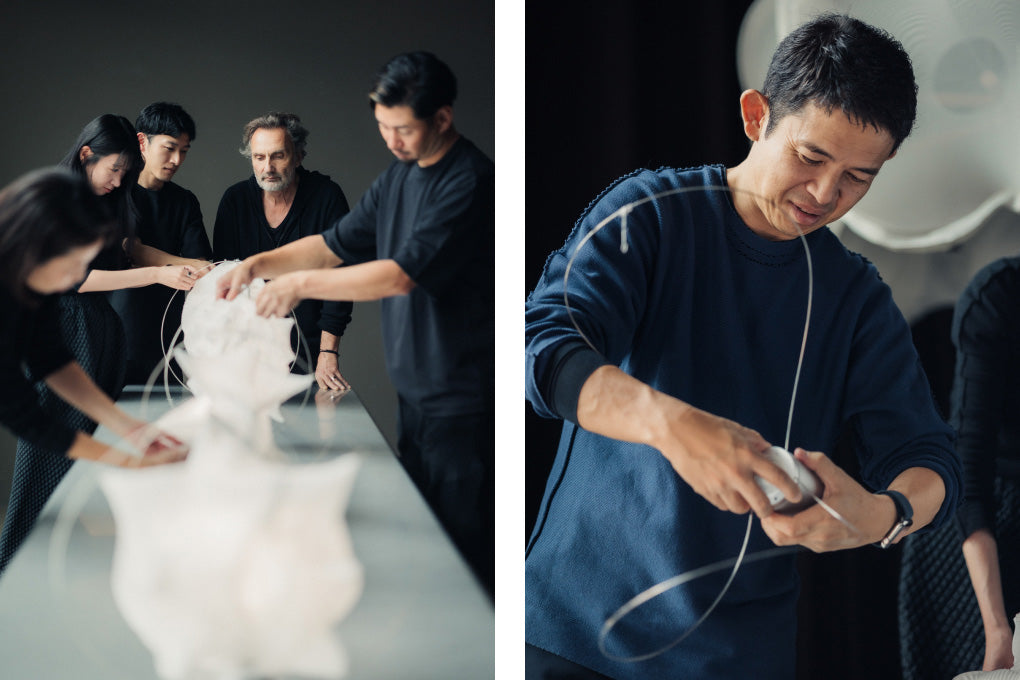
Patrick: Exactly. We are always exploring materials, capturing the essence of the project and product, and seeking the right balance. Of course in the end, we return to our five senses. By facing this process as a team, we share it with each other, hold multiple perspectives, and enrich our memories.
This “memory” is also a critical element of our creative process. The memory of things we’ve worked on, the memory of shared moments. And the memories with collaborators and friends, like in this project. These memories are often immediate, almost like a scent. For example, when you’re with a friend and you witness something in the city, there’s no need to put it into words. You just exchange a glance and smile at each other. You don’t need to say anything, but it’s as if you’re thinking, “This is exactly the same as that moment we shared before.” This kind of instant recall of memories is the essence of memory.
Scent has an even more powerful ability to evoke memories. Sometimes, when you step into a room, you suddenly feel something familiar, like the smell of your old school, your grandmother’s house, or the rain on a summer’s day. These sensory connections with memories play an incredibly important role when creating a story or redefining something.
Miyamae: I see. That’s a beautiful story. The more memories you accumulate, the more drawers you have and life becomes richer. And your intuitive judgments and the range of your ideas also expand. When you think about it like that, it’s clear that even the everyday experiences and interactions with people all connect to creation.
Patrick: Exactly. I’m convinced that memories are the most valuable thing. “Money Is Nothing But Memories”: memories are what truly matter.
That’s why I gain my energy from things like constant change, exploration, remembering, collaborating, and traveling. For me, value doesn’t come from money or material wealth. The most important thing is memories.
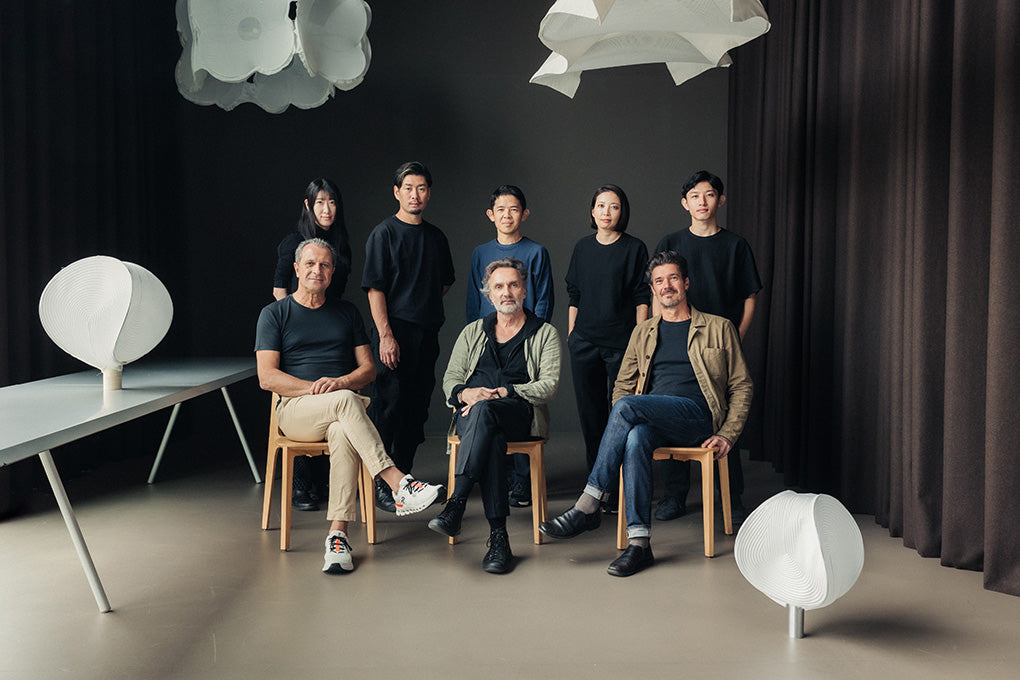
atelier oï
atelier oï was founded in 1991 in La Neuveville, Switzerland by Aurèle Aebi, Armand Louis and Patrick Raymond. Their work embodies a spirit of teamwork and a deep connection with materials. With a multidisciplinary team of 40 people, they work across disciplines, fusing architecture, interior design, product design and scenography to reinterpret natural phenomena and craftsmanship. In addition to their work on humanitarian projects in Cambodia, they have gained worldwide recognition through their numerous awards and collaborations with a wide range of global brands.










